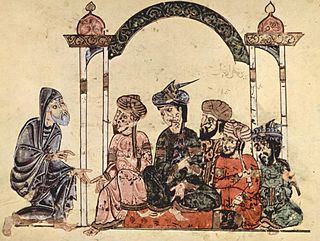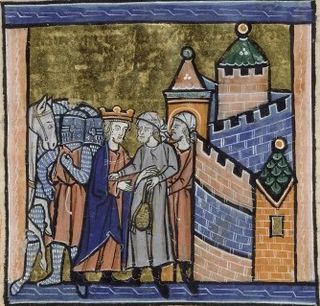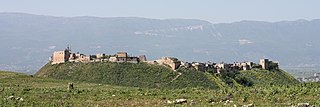Related Research Articles
Majd ad-Dīn Usāma ibn Murshid ibn ʿAlī ibn Munqidh al-Kināni al-Kalbī or Ibn Munqidh was a medieval Arab Muslim poet, author, faris (knight), and diplomat from the Banu Munqidh dynasty of Shaizar in northern Syria. His life coincided with the rise of several medieval Muslim dynasties, the arrival of the First Crusade, and the establishment of the crusader states.

Kitab al-I'tibar is the autobiography of Usama ibn-Munqidh, an Arab Syrian diplomat, soldier of the 12th century, hunter, poet and nobleman.

Shaizar or Shayzar is a town in northern Syria, administratively part of the Hama Governorate, located northwest of Hama. Nearby localities include, Mahardah, Tremseh, Kafr Hud, Khunayzir and Halfaya. According to the Syria Central Bureau of Statistics (CBS), Shaizar had a population of 5,953 in the 2004 census.

Monieux is a commune in the Vaucluse department in the Provence-Alpes-Côte d'Azur region in southeastern France.

Al-Faḍl ibn Ṣāliḥ ibn ʿAlī ibn ʿAbd Allāh ibn al-ʿAbbās (740–789) was the Abbasid governor of a number of different provinces in Syria during the late 8th-century CE. He was also governor of Egypt for a brief period of time. He was related to the Abbasid caliphs and was part of the Banu Salih branch of the Abbasid dynasty.
Ṣāliḥ ibn ʿAlī ibn ʿAbd Allāh ibn al-ʿAbbās (711–769) was a member of the Banu Abbas who served as general and governor in Syria and Egypt.
Thabit ibn Nasr ibn Malik al-Khuza'i was an Abbasid general and governor of the Cilician frontier zone with the Byzantine Empire in 808–813.

The siege of Shaizar took place from April 28 to May 21, 1138. The allied forces of the Byzantine Empire, Principality of Antioch and County of Edessa invaded Muslim Syria. Having been repulsed from their main objective, the city of Aleppo, the combined Christian armies took a number of fortified settlements by assault and finally besieged Shaizar, the capital of the Munqidhite Emirate. The siege captured the city, but failed to take the citadel; it resulted in the Emir of Shaizar paying an indemnity and becoming the vassal of the Byzantine emperor. The forces of Zengi, the greatest Muslim prince of the region, skirmished with the allied army but it was too strong for them to risk battle. The campaign underlined the limited nature of Byzantine suzerainty over the northern Crusader states and the lack of common purpose between the Latin princes and the Byzantine emperor.

Qalaat al-Madiq is a town and medieval fortress in northwestern Syria, administratively part of the Hama Governorate, located northeast of Hama. It is situated in the al-Ghab plain, on the eastern bank of the Orontes River. Nearby localities include the district center al-Suqaylabiyah to the south, Bureij and Karnaz to the southeast, Kafr Nabudah to the east, al-Huwash to the north, Huwayjah al-Sallah and Shathah to the northwest and Al-Tuwayni and Ennab to the west. According to the Syria Central Bureau of Statistics (CBS), Qalaat al-Madiq had a population of 12,925 in the 2004 census. It is the administrative center and second largest locality in the Qalaat al-Madiq nahiyah ("subdistrict") which consisted of 40 localities with a collective population of 85,597 in 2004. The town's inhabitants are predominantly Sunni Muslims.
Yahya ibn Mu'adh ibn Muslim was a senior official and governor for the Abbasid Caliphate.
Tell Mannas, sometimes spelled Telminnes, Tal Minnis, Talmanis, Talmanes or Telmans, is a village 5 kilometers (3.1 mi) east of Maarrat al-Nu'man. The village is administratively a part of the Maarrat al-Nu'man District in the Idlib Governorate. According to the Syria Central Bureau of Statistics (CBS), Tell Mannas had a population of 11,359 in the 2004 census.
Nasr ibn Shabath al-Uqayli was the leader of a rebellion of the Qays tribe in the Jazira against the central Abbasid government during the civil war of the Fourth Fitna.
Kafartab was a town and fortress in northwestern Syria that existed during the medieval period between the fortress cities of Maarat al-Numan in the north and Shaizar to the south. It was situated along the southeastern slopes of Jabal al-Zawiya. According to French geographer Robert Boulanger, writing in the early 1940s, Kafartab was "an abandoned ancient site" located 2.5 mi (4.0 km) northwest of Khan Shaykhun.
Ziyād ibn ʿAbd Allāh ibn Yazīd ibn Muʿāwiya, commonly known as Abū Muḥammad al-Sufyānī was an Umayyad prince and a pretender to the Umayyad Caliphate, which had been overthrown by the Abbasid Caliphate in early 750. Abu Muhammad led a revolt against the Abbasids, but his forces were defeated and he fled to the Hejaz, where he was killed in the early part of the Abbasid caliph al-Mansur's reign.
Majzaʾa ibn al-Kawthar ibn Zufar ibn al-Ḥārith al-Kilābī, commonly known as Abū al-Ward, was a mid-8th century Umayyad governor of Jund Qinnasrin in Syria. He was a cavalry commander of Umayyad Caliph Marwan II and later the leader of a rebellion against the Abbasid Caliphate in Syria which aimed to reestablish the Umayyad Caliphate in 750.
The Saif, sometimes called a shamshir, depending on the era, has its origins in Arabia prior to the 7th century. Not much is known about this particular weapon, other than what Al-Kindi wrote in his treatise On Swords in the 9th century.

The Banu Munqidh, also referred to as the Munqidhites, were an Arab family that ruled an emirate in the Orontes Valley in northern Syria from the mid-11th century until the family's demise in an earthquake in 1157. The emirate was initially based in Kafartab before the Banu Munqidh took over the fortress of Shayzar in 1081 and made it their headquarters for the remainder of their rule. The capture of Shayzar was the culmination of a long, drawn-out process beginning with the Banu Munqidh's nominal assignment to the land by the Mirdasid emir of Aleppo in 1025, and accelerating with the weakened grip of Byzantine rule in northern Syria in the 1070s.
The Homs revolts of 854–855 were a series of armed uprisings that took place in Homs in northern Syria. During the autumns of both 854 and 855 the city's inhabitants attempted to rebel against local government officials, resulting in both instances in several fatalities and necessitating the intervention of the Abbasid central government in response. The second revolt also resulted in the promulgation of a number of anti-Christian edicts due to the participation of a portion of the city's Christians in the incident.
Abān ibn Muʿāwiya ibn Hishām ibn ʿAbd al-Malik was an Umayyad prince and commander who led a failed revolt against the Abbasid Caliphate shortly after the toppling of the Umayyad Caliphate in 750.
Abu’l-Faḍl ʿAbbās ibn Abī al-Futūḥ al-Ṣinhājī, also known by the honorific al-Afḍal Rukn al-Dīn, was a prince of the Zirid dynasty of Ifriqiya who served as vizier of the Fatimid Caliphate in 1153–1154.
References
- ↑ "Faculty Profiles". Department of Near Eastern Languages and Cultures at the University of Pennsylvania. Retrieved 2014-02-07.
- ↑ May, Timothy (March 2009). "Review: Assessing Saladin". H-Net. Retrieved 2014-02-07.
- ↑ White Banners. SUNY Press. Retrieved 2014-02-07.
- ↑ The Race for Paradise. Oxford University Press. 2014. ISBN 978-0-19-935811-3 . Retrieved 2014-02-07.